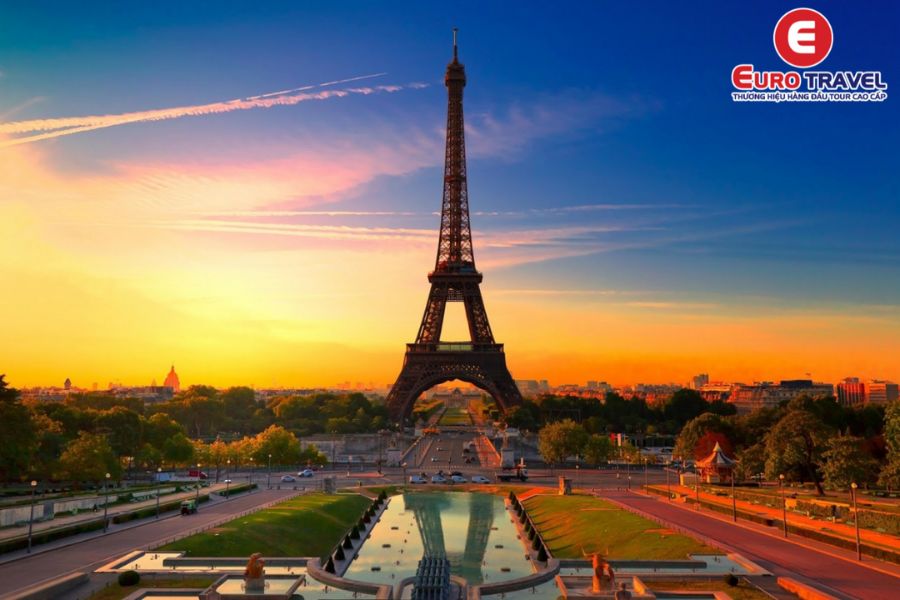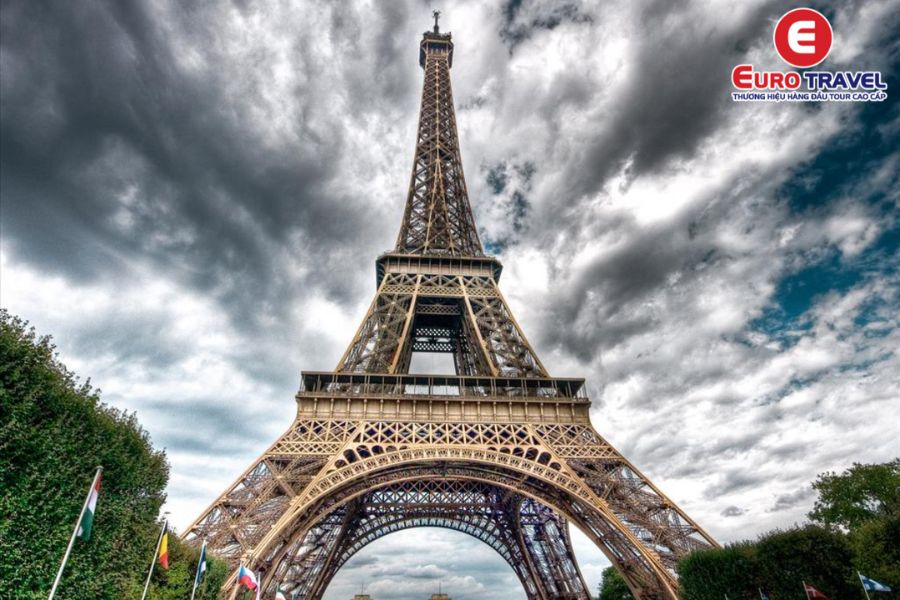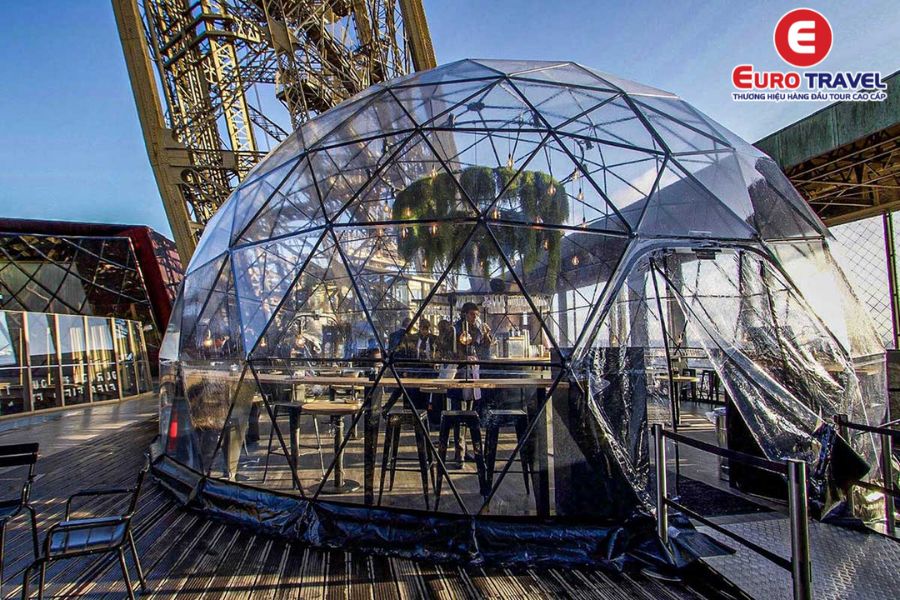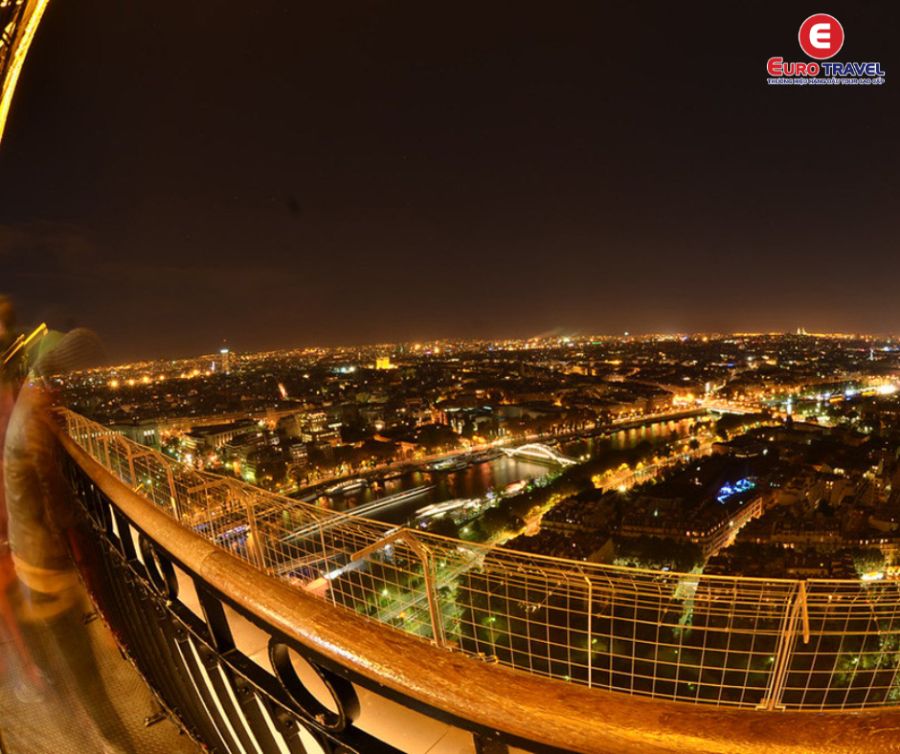Explore the Eiffel Tower - Famous symbol of Paris, France
Eiffel Tower - The tower is not only a symbol of Paris but also of France, one of the most famous buildings in the world. Completed in 1889, this tower quickly became one of the steel structures that attracted the attention of many tourists coming to Paris. In the article below, join EuroTravel to learn about some outstanding architectural features of the Eiffel Tower, as well as a specific itinerary to visit this famous tower. 1. Some details about the Eiffel Tower
1. Some details about the Eiffel Tower
The Eiffel Tower is a famous structure made of steel, located in Champ-de-Mars park in Paris, France. This tower was built in 1884 to commemorate the 100th anniversary of the French Bourgeois Revolution. With a construction time of up to 26.5 months, the tower was completed in 1889 and was expected to become "the pinnacle of the world exhibition" in 1889 in Paris.
The Eiffel Tower was not only built to commemorate, but through this architecture the French also wanted to assert themselves as an industrial power in the world, while also demonstrating the pioneering and leadership of French architecture. in the use of construction materials such as iron, steel, cast iron... The cost of building the Eiffel Tower was up to more than 800 thousand francs, so the overall and details of this tower are considered extremely delicate, precise and meticulous. There were no casualties during more than 2 years of building the tower, all details and drill holes fit well. Therefore, it is no exaggeration that the Eiffel Tower is always considered a great miracle in the history of world construction and architecture.
The cost of building the Eiffel Tower was up to more than 800 thousand francs, so the overall and details of this tower are considered extremely delicate, precise and meticulous. There were no casualties during more than 2 years of building the tower, all details and drill holes fit well. Therefore, it is no exaggeration that the Eiffel Tower is always considered a great miracle in the history of world construction and architecture. In fact, the Eiffel Tower is not the work of Gustave Eiffel, but was designed by two senior engineers Maurice Koechlin and Emile Nouguier. After chief architect Stephen Sauvestre's design was approved by Gustave Eiffel, the right to build this tower was registered under three names, including Eiffel, Koechlin and Nouguier. However, very soon Gustave Eiffel bought the construction rights from these two engineers to have exclusive rights to the tower in the future.
In fact, the Eiffel Tower is not the work of Gustave Eiffel, but was designed by two senior engineers Maurice Koechlin and Emile Nouguier. After chief architect Stephen Sauvestre's design was approved by Gustave Eiffel, the right to build this tower was registered under three names, including Eiffel, Koechlin and Nouguier. However, very soon Gustave Eiffel bought the construction rights from these two engineers to have exclusive rights to the tower in the future.
2. Architecture of the Eiffel Tower
The Eiffel Tower of France has the original height of the Eiffel Tower of 300m. Later, an antenna was added to the top so the tower reached a height of 325m, equivalent to a 100-storey building. The tower body is made entirely of steel, with a weight of up to 9,000 tons and a total of more than 12,000 metal welded parts. For this reason, the Eiffel Tower has thermal expansion, leading to height differences in winter and summer. In the summer, the Eiffel Tower will be about 17cm higher, and decrease by 10-20cm in the winter. The tower has a total of 3 observation decks at the top, middle and bottom, accommodating up to 10,000 people at the same time. Elevators are located from the ground to the top of the tower, or people can also take the stairs with a total of 1710 steps. The observatory on the top floor is 276m above the ground and has an area of 350 square meters. The observatory on the middle floor is 115m above the ground.
The tower has a total of 3 observation decks at the top, middle and bottom, accommodating up to 10,000 people at the same time. Elevators are located from the ground to the top of the tower, or people can also take the stairs with a total of 1710 steps. The observatory on the top floor is 276m above the ground and has an area of 350 square meters. The observatory on the middle floor is 115m above the ground.
Standing on the Eiffel Tower, visitors can easily see the entire city of Paris in their sight.
3. Journey to explore the Eiffel Tower
First floor of the Eiffel Tower
On the first floor, the four-legged structure of the Eiffel Tower will form a large square with a height of 125m, in accordance with the registration at the competition in 1886. The total height is up to 325m, equipped with 116 other antennas together. Compared to sea level, the base of the Eiffel Tower is about 33.5 meters higher. Ticket counters to visit the Eiffel Tower are currently mostly located at the foot of the North or West tower, consuming up to 2 tons of ticket paper. The elevator to the top is located at the foot of the tower on the East and West sides, the trip time is every 8 minutes. The Eiffel Tower also has a staircase located at the foot of the East Tower, with a total of 1710 steps to reach the top, but only allows visitors to reach the 3rd floor. The southern tower also has an elevator, reserved for employees and visitors to go to Le Jules-Verne restaurant on the 2nd floor.
The Eiffel Tower also has a staircase located at the foot of the East Tower, with a total of 1710 steps to reach the top, but only allows visitors to reach the 3rd floor. The southern tower also has an elevator, reserved for employees and visitors to go to Le Jules-Verne restaurant on the 2nd floor.
Second floor of the Eiffel Tower, France
The second floor of the Eiffel Tower is located at an altitude of 57m above sea level, with an area of about 4200m², square shape and maximum capacity of about 3000 people.
With a corridor design surrounding the entire second floor, visitors can enjoy panoramic views of Paris through telescopes. Each glass is also equipped with additional instructions for visitors to observe and get more information about projects in the city. The outside has the names of 72 world-famous scientists in the 18th and 19th centuries. A restaurant not to be missed when visiting the second floor of the Eiffel Tower is Altitude 95. From here, visitors can easily see the panoramic view of the city outside, or observe the inner structure of the tower. Altitude 95 means height 95m, which is the actual height of the 2nd floor of the Eiffel Tower above sea level.
On the second floor, visitors can also admire traces of ancient architecture, symbolizing the history of the tower, such as the spiral staircase leading to the top, which is an original design. of the project. Later, in 1986, the spiral staircase sections were removed to carry out some important renovations. The staircase was cut into 22 parts, of which 21 were auctioned to US collectors. The most special structure of the second floor of the tower is the observatory at the top, used to record some information about the effects of wind and thermal expansion. Gustave Eiffel's design allows the tower to withstand amplitudes of up to 70cm, but in reality it has never been to this extent. At the peak of the heat wave in 1976, the thermal expansion amplitude only reached 18cm, and 13cm during the storm in December 1999 with winds of 240km/h. This thermal expansion problem was further overcome in 1982 by Pierre Affaticati and Simon Pierra, by reinforcing the tower frame with metal materials.
The most special structure of the second floor of the tower is the observatory at the top, used to record some information about the effects of wind and thermal expansion. Gustave Eiffel's design allows the tower to withstand amplitudes of up to 70cm, but in reality it has never been to this extent. At the peak of the heat wave in 1976, the thermal expansion amplitude only reached 18cm, and 13cm during the storm in December 1999 with winds of 240km/h. This thermal expansion problem was further overcome in 1982 by Pierre Affaticati and Simon Pierra, by reinforcing the tower frame with metal materials.
3rd floor of the Eiffel Tower
The third floor of the tower has an area of 1650 square meters, can accommodate about 1600 people and is 115m above the ground, with a relatively square shape. The tower floor is designed with glass panels so that visitors can easily see the ground below, surrounded by iron mesh to ensure safety. If you want to see the whole of Paris, the 3rd floor is definitely the most ideal place. A height of 115m is optimal for observing surrounding structures. If you reach the 4th floor, it will be difficult for you to observe because the distance to the buildings is too far. According to calculations, on a clear weather day, visibility here can be up to 55km to the South, 60km to the North, 65km to the East and 70km to the West. Le Jules-Verne culinary restaurant is definitely a place not to be missed when visitors reach the 3rd floor of the Eiffel Tower. With 95 tables, this is a 1-star restaurant by Michelin and rated 16/20 by Gault-Millau. The restaurant's design tends to be discreet with muted tones and many metal sculptures dating back to 1983. Diners here can also enjoy views of Paris through transparent glass windows. . The restaurant is located at a height of 123m, has an area of 500m2 and is equipped with a private elevator at the foot of the tower. If you want to enjoy the cuisine here, you will have to book a table a long time in advance, about 1 month for lunch and 3 months for dinner.
Le Jules-Verne culinary restaurant is definitely a place not to be missed when visitors reach the 3rd floor of the Eiffel Tower. With 95 tables, this is a 1-star restaurant by Michelin and rated 16/20 by Gault-Millau. The restaurant's design tends to be discreet with muted tones and many metal sculptures dating back to 1983. Diners here can also enjoy views of Paris through transparent glass windows. . The restaurant is located at a height of 123m, has an area of 500m2 and is equipped with a private elevator at the foot of the tower. If you want to enjoy the cuisine here, you will have to book a table a long time in advance, about 1 month for lunch and 3 months for dinner.
4. Interesting things about the Eiffel Tower
The tower is not the work of Gustave Eiffel: In fact, the Eiffel Tower was designed by two senior engineers, Maurice Koechlin and Emile Nouguier. Initially, Gustave Eiffel did not pay too much attention to this project, but he introduced the above two engineers to Stephen Sauvestre - head of the architectural department in his company. After Stephen Sauvestre revised the design, Eiffel had the final design and decided to buy the tower patent.
Numbers about the Eiffel Tower: Built by 300 workers, 18,038 pieces of iron, 2.5 million rivets, weight of 10,000 tons and height of 300m.
The Eiffel Tower was built to become a symbol of science: Eiffel commented that the Eiffel Tower is not only modern architectural art, but also a picture reflecting the rise of the era of science and industry. at that time. At the time the tower was being built, photography was in its infancy, and many moments of the construction process were captured by photographers.
The Eiffel Tower is the tallest tower in the world: The Eiffel Tower always held this record until it was usurped by New York City's Chrysler Tower (318m) in 1930
.The Eiffel Tower has survived many historical events: During World War I, the Eiffel Tower was used to transmit radio signals. During World War II, the elevator cables to the tower were cut so the Nazis could not use the tower (after Union troops entered the city, the elevator system was restored). The Eiffel Tower even survived a fire on the top floor. Up to now, this tower has attracted 250 million tourists worldwide.
The Eiffel Tower is not painted in just one color: To create harmony, the tower is painted dark at the top and gradually brightens as it goes down. Protection work for the tower: Each year, about 50-60 tons of paint are used to protect the tower from rust. It can be seen that, after many historical events, the Eiffel Tower is still one of the greatest architectural works in Paris, a tourist destination that attracts the most tourists in the world. If you are planning to visit the Eiffel Tower in Paris, France, please contact EuroTravel immediately to experience Europe's leading tour, with many of the most advanced and premium services at the present time. in.
It can be seen that, after many historical events, the Eiffel Tower is still one of the greatest architectural works in Paris, a tourist destination that attracts the most tourists in the world. If you are planning to visit the Eiffel Tower in Paris, France, please contact EuroTravel immediately to experience Europe's leading tour, with many of the most advanced and premium services at the present time. in.





































